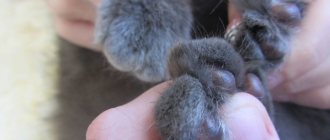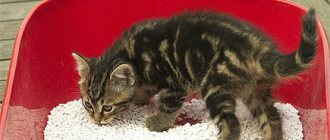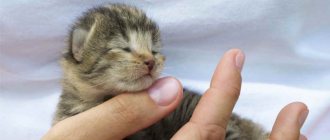When can you take a kitten from a cat: the ideal time to give away kittens
It is better to take a kitten from a cat at the age of 1.5-2 months.
There is no need to rush to remove the baby from the mother.
Veterinarians justify this figure with the following facts:
- kittens feed on mother's milk for 4-5 weeks;
- by the 7-8th week, the babies have already completely switched to adult food;
- after 1.5 months, babies actively explore the territory and are not so attached to the parent, the stress from changing homes will not be so strong.
A significant role is played by the fact that by the age of 2 months, babies have already received their first vaccination and immunity has been developed. The risks of developing dangerous diseases when moving to a new family are reduced.
The kitten begins to try adult food starting from the 3rd week of life.
Earlier weaning of kittens (at 4 weeks of age) is practiced if the litter is large or the mother cat is emaciated (sick).
In this case, the new owners of the animal have an additional burden in the form of feeding the kitten with special mixtures - cat milk substitutes. It is not recommended to replace the special formula with cow's milk.
Cat behavior after weaning
The period when the time has come to give up kittens from a cat is difficult and sometimes painful for both the baby and the caring mother. To minimize the stress of separation, knowledgeable breeders prepare their pets for separation in advance. Kittens begin to be left in a room separate from their mother, gradually reducing the time the animals spend together. As a rule, young animals quickly get used to this situation, and if weaning occurs in a timely manner, the babies adapt well to the new environment.
Cats react to the weaning of their offspring in different ways. Some females are worried, look for kittens around the house, and may be depressed. In this case, you can contact a veterinarian who will prescribe sedatives for restless mothers. But most cats, when weaned in a timely and properly prepared manner, react calmly to separation.
The desire of the future owner to quickly place a furry creature in the house should not run counter to the peculiarities of the physiological development and formation of the pet’s behavior. The state of health for many years to come and the correct behavior of the animal in society directly depend on the age at which the baby was taken from the mother. In this matter, you should listen to the opinion of experienced breeders and not take kittens before 2 months.
Similar articles
- How to choose the right kitten: healthy, good...
If the animal is taken from the street, then it is better to give preference to the baby. ... The most optimal age when a pet can be taken to a new home ... For information on at what age a kitten should be adopted into a home, watch this video Read more - How to determine the age of a cat by its eyes, teeth, weight...
This picture can be observed when examining the oral cavity of a cat aged 3 to 5 years. ... The color of the eyes can tell how old a kitten is. Read more
- The cat gave birth to kittens: what should the owners do next?
If there are children and other animals in the house, then it is necessary to prevent their access to newborn kittens and the mother. … 1) To stimulate lung function, you can perform artificial respiration in the mouth using a straw or small… Read more
- When to castrate a cat: everything owners need to know
An effective change in the sexual behavior of an animal after castration directly depends on what age... If for some reason an adult animal was not castrated, the operation can be performed at an older age, up to 7 years. Read more
- How to make friends between cats, how to reconcile two...
The best option is kittens of the same age. ... If an elderly cat lives in the house, then the appearance of a small, restless kitten will not be the best option. Read more
How long does it take to wean a kitten, what should they do themselves?
The kitten begins to try adult food starting from the 3rd week of life. Young animals begin to eat the same food that their mother eats.
By the 7th week, all the babies' teeth have erupted and they are ready to completely give up milk from the cat's breast.
Be sure to read:
A cat drags kittens, hides them and moves them to another place: reasons, what to do, what can happen
By the time the animal moves to new owners, it has some skills that make it easier for new owners to care for it:
- The cat teaches hygiene to the offspring. Babies already know how to lick their fur and wash themselves.
- The period from 1.5 to 2 months is the right time to teach the offspring to go to the toilet in a tray. The children, following their mother, use the smell to find the place where they need to do their business. It is more difficult for a person to explain to a kitten where to go to the toilet.
- The age of 7-8 weeks corresponds to the development of a child 2-3 years old . The animal's behavior is almost no different from children's games: kids explore the territory, try everything, play noisily with their brothers and sisters.
When a baby arrives in the house, you need to prepare not only a tray, a sleeping basket and food, but also several suitable toys: a ball, a soft toy, a rubber mouse.
From the history
Furry pets have gained great authority throughout the history of mankind. They were the subject of worship in Egypt, personifying the goddess of love among the Vikings. But cats were admired not only for their natural attractiveness, because they were also excellent hunters of mice and rats. Thanks to this ability, furry pets have taken root in Europe.
In the Middle Ages, the British and other European peoples believed that cats were companions of witches, and they began to destroy them. The event became one of the reasons for the emergence of the plague: after all, there was no one to kill infectious rodents.
Gradually, the authority of pets has been revived, and now they are found in almost every home. At what age are kittens taken from a cat, what breeds are pets, what is their cost and the peculiarities of upbringing - all this is described below.
How to wean a kitten from mother's milk?
At the age of 2 months, animals no longer need milk.
It is difficult to overestimate the importance of mother's milk for a kitten: with it, the baby receives not only nutrients, but also the necessary antibodies to strengthen the immune system.
But at the age of 2 months, animals no longer need milk as the only source of nutrition. They can continue to suckle a cat simply out of habit for up to six months. Usually the cat itself drives away annoying teenagers, keeping them away from the nipples.
Advice! If older kittens do not give the cat rest, tugging at her nipples, she is given a fabric blanket. It is necessary to ensure that milk does not accumulate in the nipples. If lactation is not yet completed, once a day the young animals are allowed to suck the milk from their mother.
You can make the transition to adult feeding easier for the cubs by additionally providing dairy products: yogurt with natural sourdough, without sugar and fruit additives, low-fat cottage cheese.
The main food for a baby weaned from a cat is meat: boiled beef and chicken, rabbit. You can give special canned meat for kittens.
Be sure to read:
Mating males and females: features, age, how to determine readiness, first mating, recommendations
At what age should a kitten be given away?
The usual age at which we usually pick up kittens is 6-7 weeks, however, veterinarians say that kittens at this age are almost like babies and should not be taken from their mother.
The optimal age when you can give away kittens is considered to be 10-12 weeks, because it is at this moment that kittens become independent and no longer need their mother.
It is highly recommended not to neglect this age, because it is during this period of a child’s life that critical changes occur in the child’s psychological and emotional development. If you take it away from its mother earlier, you can seriously injure the animal.
girl and kitten
How to introduce kittens to solid food?
The process of accustoming a young body to adult food takes a couple of weeks.
As a rule, by the time the baby becomes interested in the contents of the mother's bowl, several teeth have already erupted. The kitten is offered soft cottage cheese, slightly diluted with yogurt or cat milk replacer.
At another feeding they offer meat pate. Gradually, you can replace finely ground food with small and then large pieces.
Breeders feed the cubs 2-3 times a day, taking them away from their mother to another room. The food is distributed into bowls and each kitten's face is lightly dipped into the food.
The process of accustoming a young body to adult food takes a couple of weeks.
Starting to lick his lips, the baby involuntarily eats the first portions of food. The amount of food should not be large, 1 teaspoon is enough.
So that kids don’t get scared in an unfamiliar environment, they communicate with them: they talk affectionately, pet them.
Behavior and social adaptation
Many people believe that they should take a cat home as early as possible so that the animal has time to get used to them. However, cats that are too young are not yet capable of social adaptation and it is difficult for them to get used to changing owners. Before giving away kittens, the breeder needs to monitor their behavior.
An adult cat should gradually train her children, give them new knowledge and make kittens resistant to stressful situations. If the change of owner occurs too early, cats begin to perceive him as a surrogate mother. This can be seen in the behavior of babies: kittens begin to suck and lick buttons and clothes, risking introducing bacteria into their fragile bodies.
The development and formation of social adaptation skills in cats occurs within 8-10 weeks and begins in the second month of life. During this period, babies must be with their cat mother, who will teach them to explore the world.
Also at this time, communication with new people in familiar conditions and in the company of the mother cat has a good effect on cats. This will relieve kittens from fear of strangers. Therefore, it is recommended to introduce the pet to the future owner in advance, but not yet give it into the wrong hands. At what age can a kitten be given away?
Kittens that are physically and mentally strong can be given away from the age of 12 weeks. Often at this stage of life animals:
- Weaned from the mother cat's breast;
- Eat solid foods on their own;
- Know the basic rules of behavior in the house;
- They know how to go to the toilet in their litter box;
- Adapted to communicating with different people;
- Have completed the required vaccination course;
- Trained to explore the world and the environment;
- Confident and ready to move and meet new people.
The cat must understand: it is being taken to live in another family, where it will not need love and affection. The kitten must be healthy and fit for the breeder to give it away without risk or fear.
Before giving away a kitten, the breeder must inform the new owners of the pet about the peculiarities of its behavior, taste habits, character and manifestations of temperament. And new cat owners should be patient, purchase the right and healthy food for the baby, and choose a place for the cat’s tray and sleep. Then the cat’s adaptation will take place quickly, which will cause less trouble for both the pet and its new owners.
Many people still believe in the common myth that the sooner you adopt a kitten, the more affectionate and devoted it will be. However, this is not at all true. International veterinary associations advocate that kittens should not be taken away from their mother as early as possible, but should be allowed to become more independent.
People who want to have a kitten dream that it will grow up before their eyes, become very used to them and become attached to them. They believe that an older animal will no longer have such tender feelings for them. But that's not true. Even if you buy a kitten that is 12 weeks old or more, it will form an excellent bond with its new owners.
If a pet is taken from its mother very early, it will mistake the owner for a new mother. They may begin to suck on buttons or the edges of clothing. Such actions, although very cute, can still lead to adverse psychological consequences for the pet. As a result, the animal will become too dependent on humans.
It is important to know that the rules of behavior are learned by a kitten at the age of 4-14 weeks. During this entire period, their mother teaches them to explore the world around them. In the period from 2 to 14 weeks, learning the rules of behavior with one’s own kind takes place. The kitten learns this by interacting with its mother and other kittens.
It is also very important during this period for a small pet to communicate with people. Kittens must learn not to be afraid of strangers.
If you give your animal time to learn the rules of communication, it will be more patient and calm as an adult.
how to accustom a kitten to its name
What to do if the kitten is left without a mother?
Newborn kittens must be kept warm. To imitate the warm side of their mother for them, a heating pad with hot water is placed in the box with the babies. The temperature of the heating pad should be 40 degrees.
Babies are fed from a pipette or a special nipple. Cat milk or its substitute can be purchased at a pet store or veterinary pharmacy. The mixture is heated to a “steamy” temperature (this is +38 degrees) and fed to the babies.
The problem is the frequency of feedings per day. Up to 2 weeks, the cub should eat every 3 hours. From 2 to 4 weeks, the intervals between meals are increased to 4-5 hours. From 5 weeks, kittens are fed 4 times a day.
The care system for a newborn pet looks like this:
- feeding the baby itself;
- massage the tummy and inner thighs to facilitate toileting using gentle circular movements;
- wiping with a damp cloth under the baby's tail.
In the future, artificially raised pets will not differ from ordinary kittens.
Be sure to read:
Mating a British cat: features, preparation, optimal period, how they behave, what not to do
Popular cat breeds and their costs
If we talk about the variety of furry pets, then it is really huge. However, there are a few of the most popular breeds that vary in appearance, temperament, and cost. The price also depends on the pedigree, availability of documents, vaccinations, etc.
- Scots. Wayward animals with pleasant short hair. They are very beautiful, but incredibly proud. Cost from 5,000 to 45,000 rubles.
- Sphinxes. A hairless cat with amazing warm and soft skin. Very smart and understanding pets. The cost of a kitten can reach up to 30,000 rubles.
- Siamese. Beautiful, graceful cat. Most often they are affectionate and smart. Cost – from 7,000 to 30,000 rubles.
- Maine Coon. One of the largest breeds of domestic cats. They are very fluffy, with tassels on their ears. Price – from 60,000 rubles. For breeding, kittens cost more than 100,000 rubles.
In addition to popular breeds, ordinary babies are often fathered from yard non-pedigreed cats. They are affectionate, kind and just as loved by their owners. What time you can pick up kittens from a cat will be described below. Breed also matters.
Weaning period
This period lasts from 3 weeks to 1.5 months. Mother's milk is no longer enough to meet the nutritional needs of growing kittens. It's time to introduce solid foods into your diet. In nature, the mother cat brings some of the prey to the nest for the “first hunt” of her offspring. The kitten’s dental system is formed, physiologically the body is ready to digest unfamiliar food. The babies are quite independent and outwardly look ready to leave their mother. But they still drink her milk. There is no point in specially separating kittens from their mother; this is done only in the case of numerous offspring, when feeding can result in exhaustion.
It would be a mistake to start giving away kittens at this age because the socialization period is not over yet. At this age, they are very curious, actively adopting behavioral skills, carefully watching their mother. They learn to take care of themselves, explore the cat's litter box, but these are only the first lessons and relationships with their own kind and people have not yet been formed.











